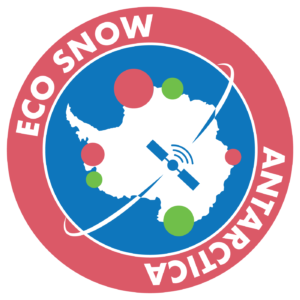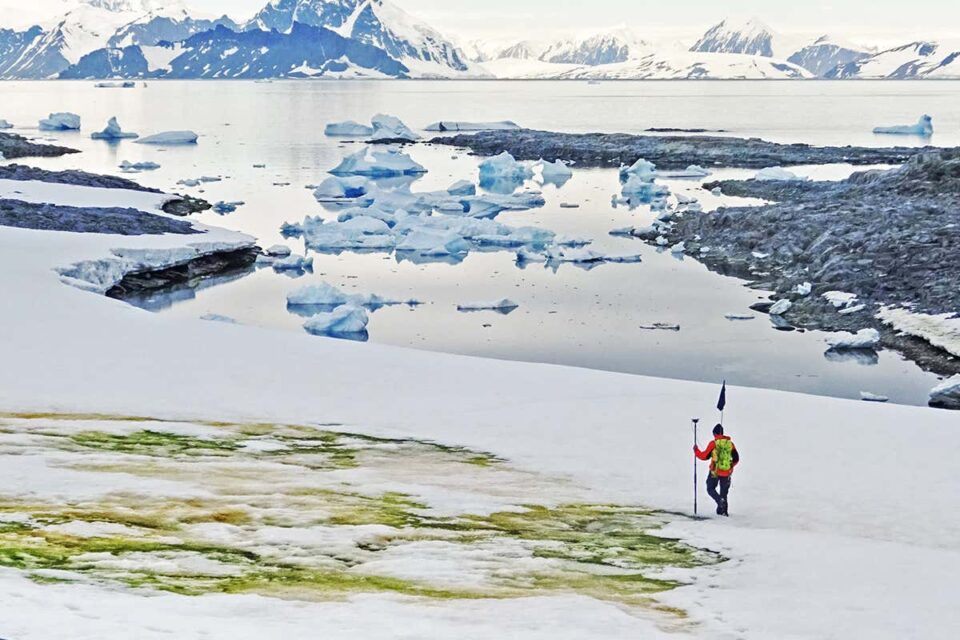 The Eco Snow project is a NERC-funded research project aiming to improve our understanding of algal blooms within Antarctic snows using a combination of field work, lab experimentation and multi-scale remote sensing methods.
The Eco Snow project is a NERC-funded research project aiming to improve our understanding of algal blooms within Antarctic snows using a combination of field work, lab experimentation and multi-scale remote sensing methods.
For project specific news, please see https://snowalgae.org/
Background
In Antarctica, less than 0.2% of the land is ice-free for at least part of the year and so is able to support terrestrial life. As in all habitats, these ecosystems have as their basis the primary producers - that is organisms that photosynthesise by using the sun's energy to capture CO2 from the atmosphere and make sugars. Even so, in the Antarctic Peninsula, only 1.34% of this exposed ground is estimated to be vegetated. Satellite images can be used to determine vegetated areas on the ground because photosynthetic organisms have distinct colours that can be detected. Perhaps surprisingly, when some of these areas have been inspected directly - in a process called ground-validation - a major group of photosynthetic organisms are snow-algae living on the surface of (or just below) the snow fields. Many species have dormant stages where they make red pigments - this has led to them being mistaken for drops of blood in the snow. As well as the fact that snow algae may be one of the major primary producers, they are also important for cycling nutrients in the habitable terrestrial regions of Antarctica. As the snow melts they are washed off into the surrounding environments providing nutrients to the adjacent land and into the sea. The contribution of snow algae to these ecosystems, both in absolute terms and relative to the area of 'true' terrestrial habitat in the Antarctic, is therefore likely to be considerable. Recently, we have carried out studies to make the first-ever large-scale area and biomass distribution map of snow algae across the whole of the Antarctic Peninsula. Essentially we have been able to record for the first time the third largest terrestrial photosynthetic ecosystem on the Antarctic Peninsula after mosses and lichens. We detected 1679 green snow algae blooms covering approximately 1.9km2, which overall was estimated to weigh 1327 tonnes and taking up 1757 tonnes of CO2 per year. We found that these blooms were influenced by both temperature and nutrients with 60% of blooms being within 5km of a penguin colony. We also found that 62% of blooms were on small, low-lying islands that, should the Peninsula continue to warm, will lose their summer snow cover along with their snow algae. However, the other larger blooms were found further north on the Peninsula, on sites that would allow the blooms to expand onto higher ground. Now we have the initial estimates of where and how much snow algae there is in one part of Antarctica it is important that we work out 1: where snow algae are in the rest of Antarctica 2, increase the detection sensitivity of our methods by using drones to detect the red as well as green blooms 3, the range of temperatures, nutrients and light required for the snow algae to bloom 4, how the snow algae compare to other major plants in the region such as lichens and mosses and 5, whether the snow algae species across Antarctica are all the same and what are they made of. We will also look at historical satellite images of Antarctica to see if the blooms are spreading, decreasing or have remained in the same places. To do this we need to carry out a comprehensive survey of snow algae blooms from detected sites all the way along the Antarctic Peninsula in 2021 and then studying one very large bloom for a whole growth season in 2022. There we will ground-truth the blooms and other vegetation and to carry out a detailed analysis of the nutrients in the snow and the photosynthetic activity of the snow algae and other plants in the area. This will allow us to estimate their overall contribution to the polar carbon budget. Once we have all this information we can make detailed models to predict how the snow algae blooms will change in location, size, biomass and species in the coming years. Overall, this will be a significant advance in our understanding of the Antarctic terrestrial ecosystem.
